The following is an important reminder of the need for all companies and institutions utilizing cooling towers, to adopt diligent maintenance and water treatment programs; Why? - Because what's at stake is worker health & safety, operational efficiency and the company's reputation. In recent years a major worldwide auto manufacturer experienced a tragedy when four of its maintenance workers became ill with pneumonia-like symptoms that ultimately claimed the lives of two. The cause - Legionnaires Disease due to Legionella bacteria found in one of the manufacturers cooling towers.
The company quickly moved to conduct a "cause analysis" by inspecting its cooling towers and boiler systems worldwide to identify how systems were being maintained and to identify best maintenance practices. This ultimately led to the establishment of a world class maintenance and monitoring system that ensures such a tragedy will never be repeated.
How a Legionella Outbreak Can Occur
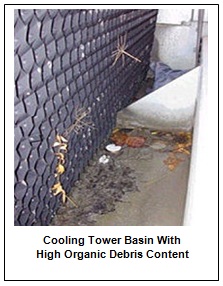 When someone becomes ill from an unsafe cooling tower it most often isn't the result of the company's blatant negligence; rather, it's typically the result of not having a clear understanding of the need for the water treatment program to be in alignment with effective debris management. It is well known that cooling towers are highly efficient air scrubbers; airborne debris drifting past one is likely to get caught in its draft and be sucked-in.
When someone becomes ill from an unsafe cooling tower it most often isn't the result of the company's blatant negligence; rather, it's typically the result of not having a clear understanding of the need for the water treatment program to be in alignment with effective debris management. It is well known that cooling towers are highly efficient air scrubbers; airborne debris drifting past one is likely to get caught in its draft and be sucked-in.
When organic debris such as pollen, cottonwood seed, leaves, insects, grass, birds etc. get into the water and decompose, the warm temperatures create a nutrient rich environment for bacterial growth including Legionella. Further, if the volume of decomposing debris exceeds the chemical dosage's ability to provide control, then the "tipping point" has been reached and the cooling tower will silently grow dangerous even while chemical dosing continues.
The fact of the matter is that it's easy for companies to develop a false sense of security that their cooling towers are safe when they are chemically treating the water; however, if organic debris management isn't in alignment with water treatment dosage levels, there is an increased probability of the tower becoming a health and safety hazard. It doesn't matter how large or small a company and its cooling tower is; bacteria doesn't discriminate - it will thrive in any poorly managed cooling tower!
An Obvious Question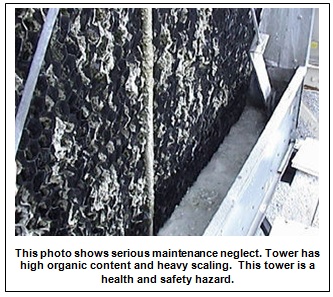 "What is the appropriate ratio of water treatment chemicals to the debris load inside the cooling tower to ensure cooling tower safety?" Although the question is obvious, the answer isn't. Organic debris is drawn into cooling towers in different concentrations depending upon location and time of year. Every type of debris places a different demand upon the biocides and scale inhibitors being dosed into the water; therefore, there is no known ratio that will hold constant for every cooling tower. However, it is safe to say that if you don't deploy diligent maintenance procedures that include debris management, more water treatment chemicals will be required to keep it safe. Some may say, "Load the tower up with chemicals to ensure safety", however, local environmental guidelines typically place restrictions on the amount and type of chemicals that can be used, therefore the use of chemical treatment alone is not the solution. Furthermore, adding chemicals to offset poor maintenance practices is a shortcut that will do little to prevent fouling and clogging of the fill, strainers, blow down valves, chiller and heat exchangers and could eventually lead to health and safety problems and a reduction in equipment performance.
"What is the appropriate ratio of water treatment chemicals to the debris load inside the cooling tower to ensure cooling tower safety?" Although the question is obvious, the answer isn't. Organic debris is drawn into cooling towers in different concentrations depending upon location and time of year. Every type of debris places a different demand upon the biocides and scale inhibitors being dosed into the water; therefore, there is no known ratio that will hold constant for every cooling tower. However, it is safe to say that if you don't deploy diligent maintenance procedures that include debris management, more water treatment chemicals will be required to keep it safe. Some may say, "Load the tower up with chemicals to ensure safety", however, local environmental guidelines typically place restrictions on the amount and type of chemicals that can be used, therefore the use of chemical treatment alone is not the solution. Furthermore, adding chemicals to offset poor maintenance practices is a shortcut that will do little to prevent fouling and clogging of the fill, strainers, blow down valves, chiller and heat exchangers and could eventually lead to health and safety problems and a reduction in equipment performance.
Although the answer to the chemical ratio to debris question isn't apparent, the answer to keeping a safe cooling tower is crystal clear and can be simply stated - "Keep the cooling tower free of debris and deploy a good water treatment program and your cooling tower will operate safely and efficiently."
How to Keep a Safe Cooling Tower
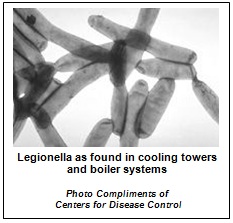 In recent years The Chartered Institution of Building Services Engineers in Europe (CIBSE) and the American Society of Heating, Refrigerating & Air-Conditioning Engineers (ASHRAE) in the US have provided excellent recommendations and guidelines for cooling tower maintenance. In addition to recommending maintenance activities, they also call for establishing procedures that are measurable. Although the suggested guidelines are excellent, companies must ultimately weigh the operational and economic realities of any maintenance program they deploy. If maintenance procedures are too frequent, cumbersome or complex, they commonly results in more downtime, lost productivity and higher maintenance costs. Conversely, if the intervals between maintenance are too long, it may be more cost effective, but the condition of the cooling tower at each maintenance interval may be less than desirable and potentially place maintenance workers, employees, tenants and the public at risk. So the answer largely lies somewhere in the middle where water treatment and managing debris in the tower come together.
In recent years The Chartered Institution of Building Services Engineers in Europe (CIBSE) and the American Society of Heating, Refrigerating & Air-Conditioning Engineers (ASHRAE) in the US have provided excellent recommendations and guidelines for cooling tower maintenance. In addition to recommending maintenance activities, they also call for establishing procedures that are measurable. Although the suggested guidelines are excellent, companies must ultimately weigh the operational and economic realities of any maintenance program they deploy. If maintenance procedures are too frequent, cumbersome or complex, they commonly results in more downtime, lost productivity and higher maintenance costs. Conversely, if the intervals between maintenance are too long, it may be more cost effective, but the condition of the cooling tower at each maintenance interval may be less than desirable and potentially place maintenance workers, employees, tenants and the public at risk. So the answer largely lies somewhere in the middle where water treatment and managing debris in the tower come together.
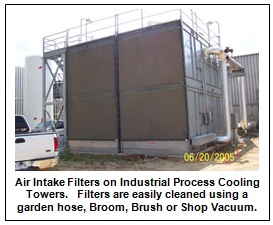 Today, companies have many options available for managing debris; they include a variety of water based filtration technologies and air intake filtration. Water filtration can help manage waterborne and other debris after it gets into the cooling water while Air intake filtration technology is highly effective at stopping airborne debris from getting into the tower by filtering the air as it enters the system. When determining what maintenance and debris management technology to use, it is important to first determine what the source of the debris is. If the source of debris is waterborne (e.g.; sediment, algae from pond or river, or water with a high dissolved solids content), water filtration in combination with a good water treatment program is typically the best solution and will help protect the tower and its piping from scaling and fouling. However, if the source of debris is airborne related then Air Intake Filters are the best solution because debris is stopped at its point of entry while water filtration can only help manage the airborne debris once it gets into the water basin. In combination with a good water treatment program, Air Intake Filtration is highly effective at stopping the kind of debris that clogs strainers, blow down valves, fill, chillers and heat exchangers. In extreme cases where both waterborne and airborne debris is problematic, both air intake filtration and water filtration in combination with a good water treatment program may be required in order to keep the cooling tower safe and operating efficiently.
Today, companies have many options available for managing debris; they include a variety of water based filtration technologies and air intake filtration. Water filtration can help manage waterborne and other debris after it gets into the cooling water while Air intake filtration technology is highly effective at stopping airborne debris from getting into the tower by filtering the air as it enters the system. When determining what maintenance and debris management technology to use, it is important to first determine what the source of the debris is. If the source of debris is waterborne (e.g.; sediment, algae from pond or river, or water with a high dissolved solids content), water filtration in combination with a good water treatment program is typically the best solution and will help protect the tower and its piping from scaling and fouling. However, if the source of debris is airborne related then Air Intake Filters are the best solution because debris is stopped at its point of entry while water filtration can only help manage the airborne debris once it gets into the water basin. In combination with a good water treatment program, Air Intake Filtration is highly effective at stopping the kind of debris that clogs strainers, blow down valves, fill, chillers and heat exchangers. In extreme cases where both waterborne and airborne debris is problematic, both air intake filtration and water filtration in combination with a good water treatment program may be required in order to keep the cooling tower safe and operating efficiently.
Personal Safety
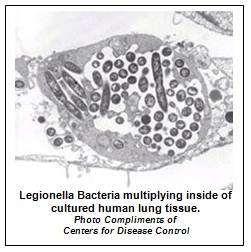 No matter what cooling tower maintenance procedures are adopted, personal safety precautions must be integral to the maintenance procedures. Best practices require workers to wear respirators, gloves and protective clothing to help prevent exposure to water treatment chemicals and bacteria, especially Legionella. Important Note: cooling water doesn't have to look dirty to be dangerous - just because the water is clear doesn't mean it's clean or free of bacteria - Every cooling tower can harbor bacteria. Always take precautions because unless the water is routinely tested for Legionella and other bacteria, the bacteria will never announce its presence until it's too late.
No matter what cooling tower maintenance procedures are adopted, personal safety precautions must be integral to the maintenance procedures. Best practices require workers to wear respirators, gloves and protective clothing to help prevent exposure to water treatment chemicals and bacteria, especially Legionella. Important Note: cooling water doesn't have to look dirty to be dangerous - just because the water is clear doesn't mean it's clean or free of bacteria - Every cooling tower can harbor bacteria. Always take precautions because unless the water is routinely tested for Legionella and other bacteria, the bacteria will never announce its presence until it's too late.
Consider The Cost Of A Sick Tower
Companies that don't insist upon diligent cooling tower maintenance procedures put not only their employee's health and safety at risk, but also their business and reputation. Consider the cost of a single cooling tower related Legionella incident:
• Reduced employee moral and productivity due to an unsafe work environment.
• Negative customer perceptions and their willingness to buy goods & services should a Legionella outbreak become public. (Especially risky for food and related processors).
• Loss of income to families when a loved one becomes ill or dies from Legionnaires Disease.
• High cost of litigation which usually follows.
• Higher company insurance costs when claims due to job related sickness or death occur.
In comparison to the cost of a proactive maintenance initiative, the incidents listed above when considered individually or collectively carry staggering cost.
Follow A Leader
So, you may be wondering exactly how the major automotive company mentioned at the beginning took a tragic situation and turned it into a world-class maintenance program. They formed an oversight committee sponsored by executive management that is charged with the responsibility of working with consultants, water treatment professionals, maintenance employees and contractors to establish a global water management program that encompasses specific maintenance tasks, procedures, schedules, management accountabilities and reporting guidelines at the facility level. A representative at each facility is accountable to a regional representative who reports activities and results to the oversight committee. The establishment of the oversight committee and its global management network ensures uniformity of their program plus, gives the company a vehicle to quickly implement changes and enhancements that provide continuous improvement to their global water management program.
It Doesn't Take Rocket Science
It simply requires that companies using cooling towers "step-up" and initiate proactive and on-going maintenance procedures that align effective debris management technology with effective water testing and treatment techniques because when these elements are in alignment, the result is a safe, healthy and efficient operation.
Randy Simmons, is President of The Newway Company dba / Air Solution Company manufacturer of Intake Filter Screens for cooling towers and condenser coil based cooling systems. For questions or information, he can be reached at Tel 513-860-9784 in the US or, visit their website at www.airsolutioncompany.com
For availability in the UK, Contact ECEX on 01635 244 100 or, Visit their Website at www.ecex.co.uk
{jcomments on}



